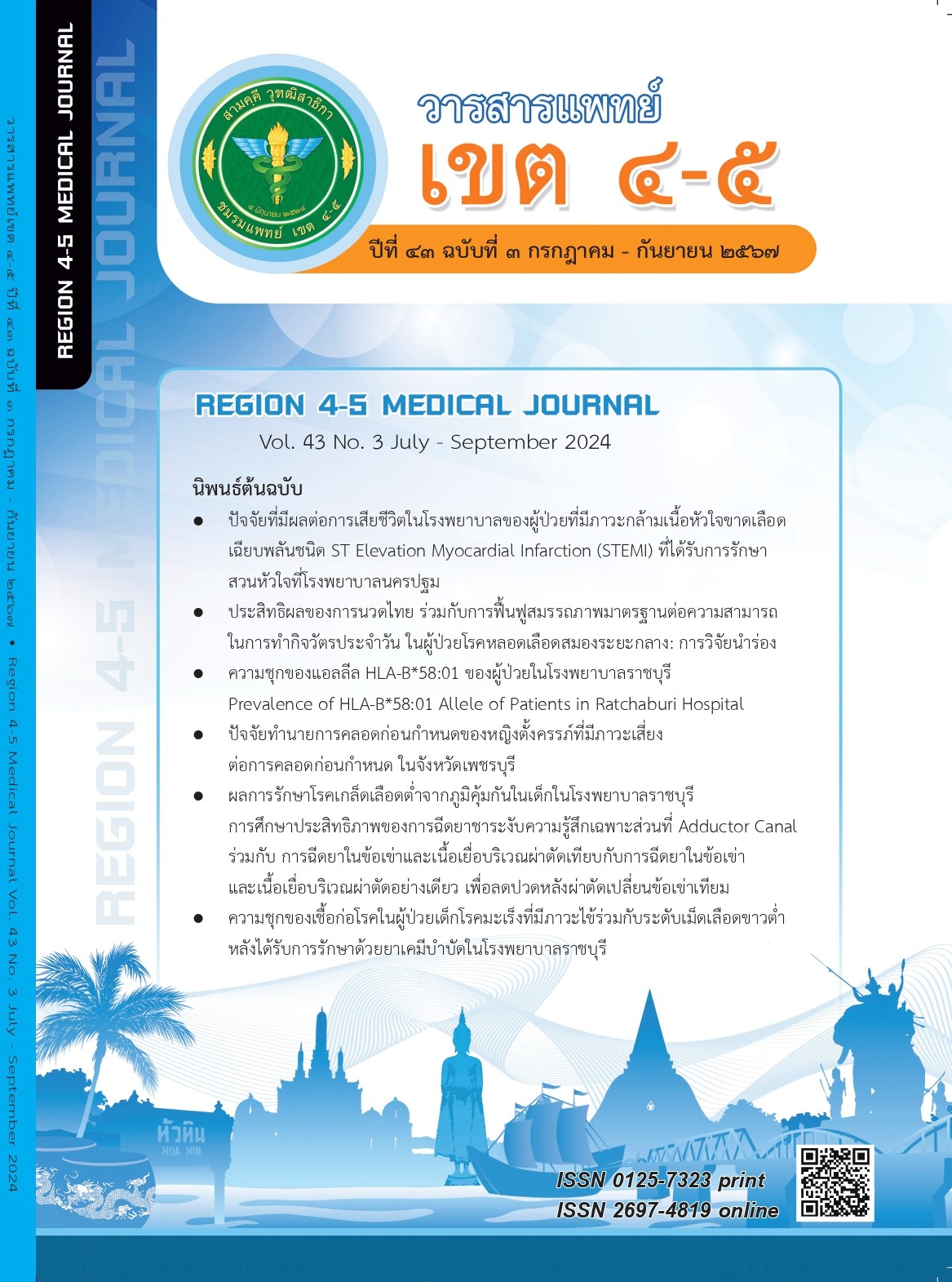Factors Associated with In-Hospital Mortality Among ST-Elevation Myocardial Infarction (STEMI) Patients Undergoing Percutaneous Coronary Intervention at Nakhonpathom Hospital
Keywords:
STEMI, mortalityAbstract
Objectives: The purpose is to identify the predictive factors of in-hospital mortality in patients with ST-elevation myocardial infarction (STEMI) undergoing primary percutaneous coronary intervention (PCI) at Nakhonpathom Hospital, a tertiary care center in Thailand.
Methods: A retrospective study was conducted on STEMI patients who undergoing primary PCI at Nakhonpathom Hospital between January 1, 2021 and December 31, 2023. Baseline characteristics and angiographic data were reviewed and recorded. The study endpoint was all-cause in-hospital mortality.
Results: Of the 252 patients were included in the study. The in-hospital mortality rate was 12.3% (31 patients). The mean age of the patients was 63 years, and 73% were male. Cardiogenic shock on admission was present in 19% of the patients. The median diagnosis-to-device time was 91 minutes. After adjustment for baseline variables, the factors significantly associated with mortality were cardiogenic shock on admission (OR 5.11, 95% CI 2.02–12.91, p < .001); final TIMI flow grade 0/1 after the procedure (OR 16.43, 95% CI 1.39–13.02, p = .011); left ventricular ejection fraction less than 40% (OR 2.71, 95% CI 1.11–6.77, p = .029); and age over 60 years (OR 2.32, 95% CI 0.81–6.65, p = .12) which was not statistically significant.
Conclusion: Cardiogenic shock, left ventricular function, and final TIMI flow are significant predictors of adverse outcomes in unselected patients with STEMI undergoing primary PCI at Nakhonpathom Hospital.
References
World Health Organization. Global action plan for the prevention and control of noncommunicable diseases 2013–2020 [Internet]. 2013 [cited 2024 August 27]; Available from: https://iris.who.int/handle/10665/94384
ศูนย์ข้อมูลข่าวสารด้านเวชภัณฑ์ กระทรวงสาธารณสุข. สถิติสาธารณสุข 2565 Public Health Statistics A.D.2022 [อินเทอร์เน็ต]. 2565 [เข้าถึงเมื่อ 27 สิงหาคม 2567]; เข้าถึงได้จาก: https://dmsic.moph.go.th/index/detail/9353
Ibanez B, James S, Agewall S, et al. 2017 ESC Guidelines for the management of acute myocardial infarction in patients presenting with ST-segment elevation. Rev Esp Cardiol (Engl Ed). 2017;70(12):1082. doi: 10.1016/j.rec.2017.11.010
สมาคมแพทยโรคหัวใจแหงประเทศไทย ในพระบรมราชูปถัมภ์. แนวเวชปฏิบัติการดูแลรักษาผูปวย ภาวะหัวใจขาดเลือดเฉียบพลัน พ.ศ.2563. สมุทรปราการ: เนคสเตป ดีไซน; 2563.
Sanguanwong S, Srimahachota S, Tungsubutra W, et al. Predictors of in-hospital mortality in Thai STEMI patients: results from TACSR. J Med Assoc Thai. 2007;90Suppl1:91–7.
สำนักงานเขตสุขภาพที่ 5. สรุปผลการดำเนินงาน เขตสุขภาพที่ 5 ประจำปีงบประมาณ 2565. ราชบุรี: สำนักงานเขตสุขภาพที่ 5; 2565.
Oraii A, Shafeghat M, Ashraf H, et al. Risk assessment for mortality in patients with ST-elevation myocardial infarction undergoing primary percutaneous coronary intervention: A retrospective cohort study. Health Sci Rep. 2024;7(2):e1867. doi: 10.1002/hsr2.1867.
Otero-García O, Cid-Álvarez AB, Juskova M, et al. Prognostic impact of left ventricular ejection fraction recovery in patients with ST-segment elevation myocardial infarction undergoing primary percutaneous coronary intervention: analysis of an 11-year all-comers registry. Eur Heart J Acute Cardiovasc Care. 2021;10(8):898–908. doi: 10.1093/ehjacc/zuab058.
Elkammash A, Abdelhamid M, Sobhy M, et al. Acute heart failure and coronary blood flow in ST-elevation myocardial infarction patients undergoing primary percutaneous coronary intervention: an observational cohort study. Cureus. 2023;15(12):e50340. doi: 10.7759/cureus.50340.
Salehi N, Motevaseli S, Janjani P, et al. Reperfusion Therapy and predictors of 30-day mortality after ST-segment elevation myocardial infarction in a university medical center in western Iran. Arch Iran Med. 2021;24(11):796–803. doi: 10.34172/aim.2021.119.
Assessment of the Safety and Efficacy of a New Treatment Strategy with Percutaneous Coronary Intervention (ASSENT-4 PCI) investigators. Primary versus tenecteplase-facilitated percutaneous coronary intervention in patients with ST-segment elevation acute myocardial infarction (ASSENT-4 PCI): randomised trial. Lancet. 2006;367(9510):569–78. doi: 10.1016/S0140-6736(06)68147-6.
Bueno H, Betriu A, Heras M, et al. Primary angioplasty vs. fibrinolysis in very old patients with acute myocardial infarction: TRIANA (TRatamiento del Infarto Agudo de miocardio eN Ancianos) randomized trial and pooled analysis with previous studies. Eur Heart J. 2011;32(1):51-60. doi: 10.1093/eurheartj/ehq375.
Dubey G, Verma SK, Bahl VK. Primary percutaneous coronary intervention for acute ST elevation myocardial infarction: Outcomes and determinants of outcomes: A tertiary care center study from North India. Indian Heart J. 2017;69(3):294–8.
Kochar A, Al-Khalidi HR, Hansen SM, et al. Delays in Primary percutaneous coronary intervention in ST-segment elevation myocardial infarction patients presenting with cardiogenic shock. JACC Cardiovasc Interv. 2018;11(18):1824–33.
Bromage DI, Jones DA, Rathod KS, et al. Outcome of 1,051 Octogenarian patients With ST-segment elevation myocardial infarction treated with primary percutaneous coronary intervention: Observational Cohort From the London Heart Attack Group. J Am Heart Assoc. 2016;5(6):e003027.
Tung BW, Ng ZY, Kristanto W, et al. Characteristics and outcomes of young patients with ST segment elevation myocardial infarction undergoing primary percutaneous coronary intervention: retrospective analysis in a multiethnic Asian population. Open Heart. 2021;8(1):e001437. doi: 10.1136/openhrt-2020-001437.
Hochman JS, Sleeper LA, Webb JG, et al. Early revascularization in acute myocardial infarction complicated by cardiogenic shock. SHOCK Investigators. Should We Emergently Revascularize Occluded Coronaries for Cardiogenic Shock. N Engl J Med. 1999;341(9):625–34.
Curtis JP, Sokol SI, Wang Y, et al. The association of left ventricular ejection fraction, mortality, and cause of death in stable outpatients with heart failure. J Am Coll Cardiol. 2003;42(4):736–42.
Koirala P, Gajurel RM, Poudel CM, et al. Study of clinical profile and outcomes of percutaneous coronary intervention in ST elevation myocardial infraction. NHJ 2019:16(2):53–7.
Cretu DE, Udroiu CA, Stoicescu CI, et al. Predictors of in-hospital mortality of ST-segment elevation myocardial infarction patients undergoing interventional treatment. An Analysis of Data from the RO-STEMI Registry. 2015;10:10(4):295–303.
Kunadian V, Qiu W, Bawamia B, et al. Gender comparisons in cardiogenic shock during ST elevation myocardial infarction treated by primary percutaneous coronary intervention. Am J Cardiol. 2013;112(5):636–41.
Al Saif SM, Al Shammeri O, Alkhushail A, et al. Transfer of patients with ST elevation myocardial infarction for primary percutaneous coronary intervention during ordinary & pandemic times position statement of the Saudi Arabian Cardiac Intervention Society. Journal of the Saudi Heart Association 2024;32(4):483–89.
Downloads
Published
How to Cite
Issue
Section
License

This work is licensed under a Creative Commons Attribution-NonCommercial-NoDerivatives 4.0 International License.
ลิขสิทธิ์บทความเป็นของผู้เขียนบทความ แต่หากผลงานของท่านได้รับการพิจารณาตีพิมพ์ลงวารสารแพทย์เขต 4-5 จะคงไว้ซึ่งสิทธิ์ในการตีพิมพ์ครั้งแรกด้วยเหตุที่บทความจะปรากฎในวารสารที่เข้าถึงได้ จึงอนุญาตให้นำบทความในวารสารไปใช้ประโยชน์ได้ในเชิงวิชาการโดยจำเป็นต้องมีการอ้างอิงถึงชื่อวารสารอย่างถูกต้อง แต่ไม่อนุญาตให้นำไปใช้ในเชิงพาณิชย์




